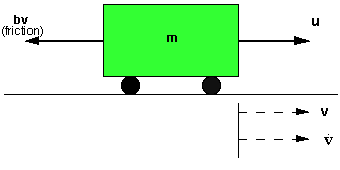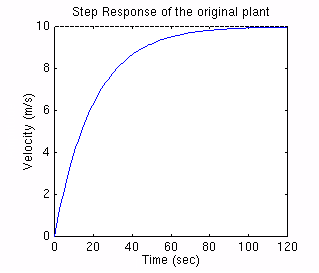Example: Modeling a Cruise Control
System
Physical setup and system equations
Design requirements
Matlab representation
Open-loop response
Closed-loop transfer function
Physical setup and system equations
The model of the cruise control system is relatively simple. If the inertia
of the wheels is neglected, and it is assumed that friction (which is
proportional to the car's speed) is what is opposing the motion of the car, then
the problem is reduced to the simple mass and damper system shown below.

Using Newton's law, modeling equations for this system becomes:
 (1)
(1)
where u is the force from the engine. For this example, let's assume that
m = 1000kg
b = 50Nsec/m
u = 500N
Design requirements
The next step in modeling this system is to come up with some design
criteria. When the engine gives a 500 Newton force, the car will reach a maximum
velocity of 10 m/s (22 mph). An automobile should be able to accelerate up to
that speed in less than 5 seconds. Since this is only a cruise control system, a
10% overshoot on the velocity will not do much damage. A 2% steady-state error
is also acceptable for the same reason.
Keeping the above in mind, we have proposed the following design criteria for
this problem:
Rise time < 5 sec
Overshoot < 10%
Steady state error < 2%
Matlab representation
1. Transfer Function
To find the transfer function of the above system, we need to take the
Laplace transform of the modeling equations (1). When finding the transfer
function, zero initial conditions must be assumed. Laplace transforms of the
two equations are shown below.

Since our output is the velocity, let's substitute V(s) in terms of Y(s)

The transfer function of the system becomes

To solve this problem using Matlab, copy the following commands into an new
m-file:
m=1000;
b=50;
u=500;
num=[1];
den=[m b];
These commands will later be used to find the open-loop response of
the system to a step input. But before getting into that, let's take a look at
another representation, the state-space.
2. State-Space
We can rewrite the first-order modeling equation (1) as the state-space
model.
 To use Matlab to solve this problem, create an new m-file and copy the
following commands:
To use Matlab to solve this problem, create an new m-file and copy the
following commands:
m = 1000;
b = 50;
u = 500;
A = [-b/m];
B = [1/m];
C = [1];
D = 0;
Note: It is possible to convert from the state-space
representation to the transfer function or vise versa using Matlab.
Open-loop response
Now let's see how the open-loop system responds to a step input. Add the
following command onto the end of the m-file written for the tranfer function
(the m-file with num and den matrices) and run it in the Matlab command window: step(u*num,den)
You should get the following plot:

To use the m-file written for the state-space (the m-file with A, B, C, D
matrices), add the following command at the end of the m-file and run it in the
Matlab command window:
step (A,u*B,C,D)
You should get the same plot as the one shown above.
From the plot, we see that the vehicle takes more than 100 seconds to reach
the steady-state speed of 10 m/s. This does not satisfy our rise time criterion
of less than 5 seconds.
Closed-loop transfer function
To solve this problem, a unity feedback controller will be added to improve
the system performance. The figure shown below is the block diagram of a typical
unity feedback system.

The transfer function in the plant is the transfer function derived above
{Y(s)/U(s)=1/ms+b}. The controller will to be designed to satisfy all design
criteria. Four different methods to design the controller are listed at the
bottom of this page. You may choose on PID, Root-locus, Frequency response, or
State-space.
[ Table des matières ]

 (1)
(1)




